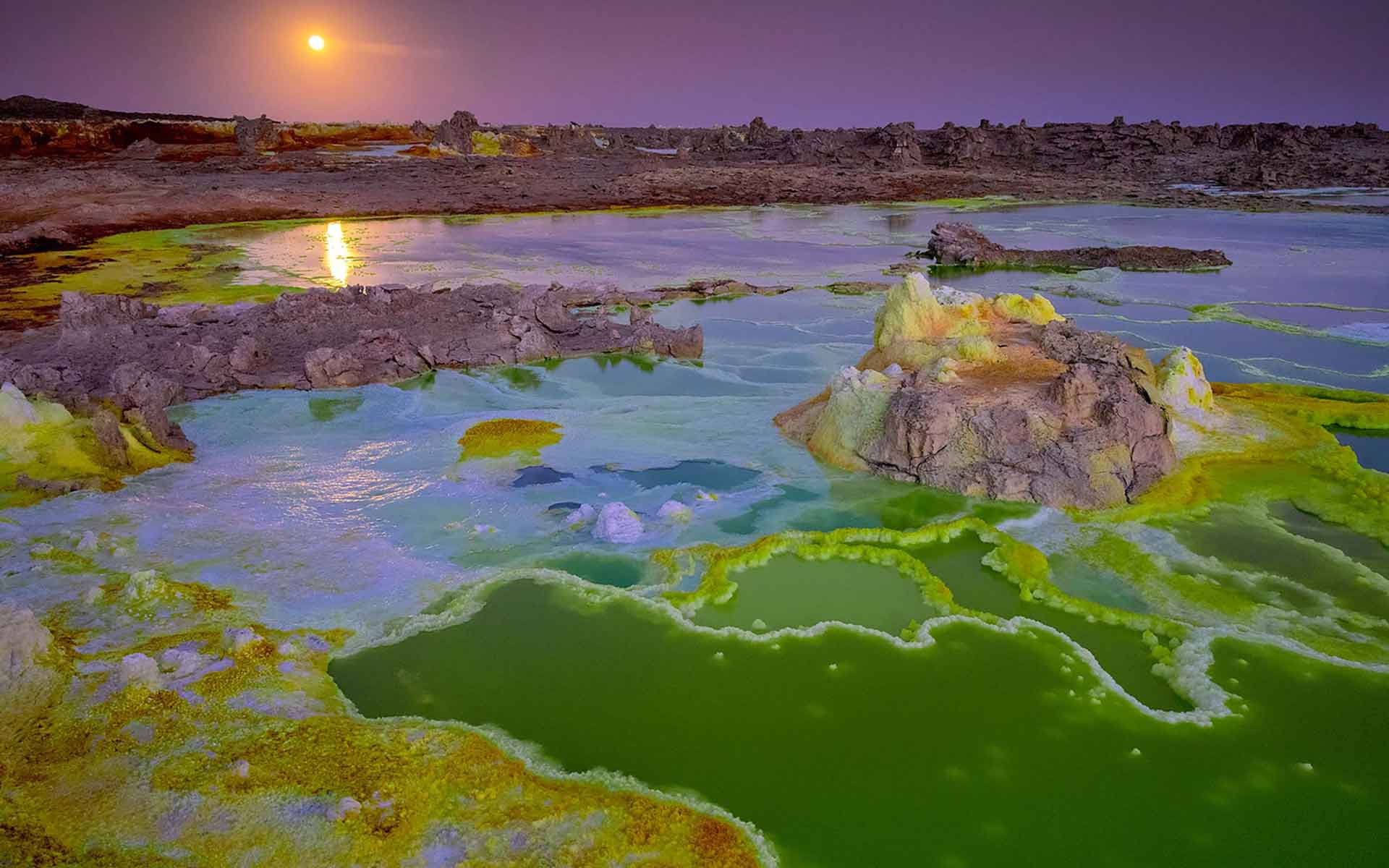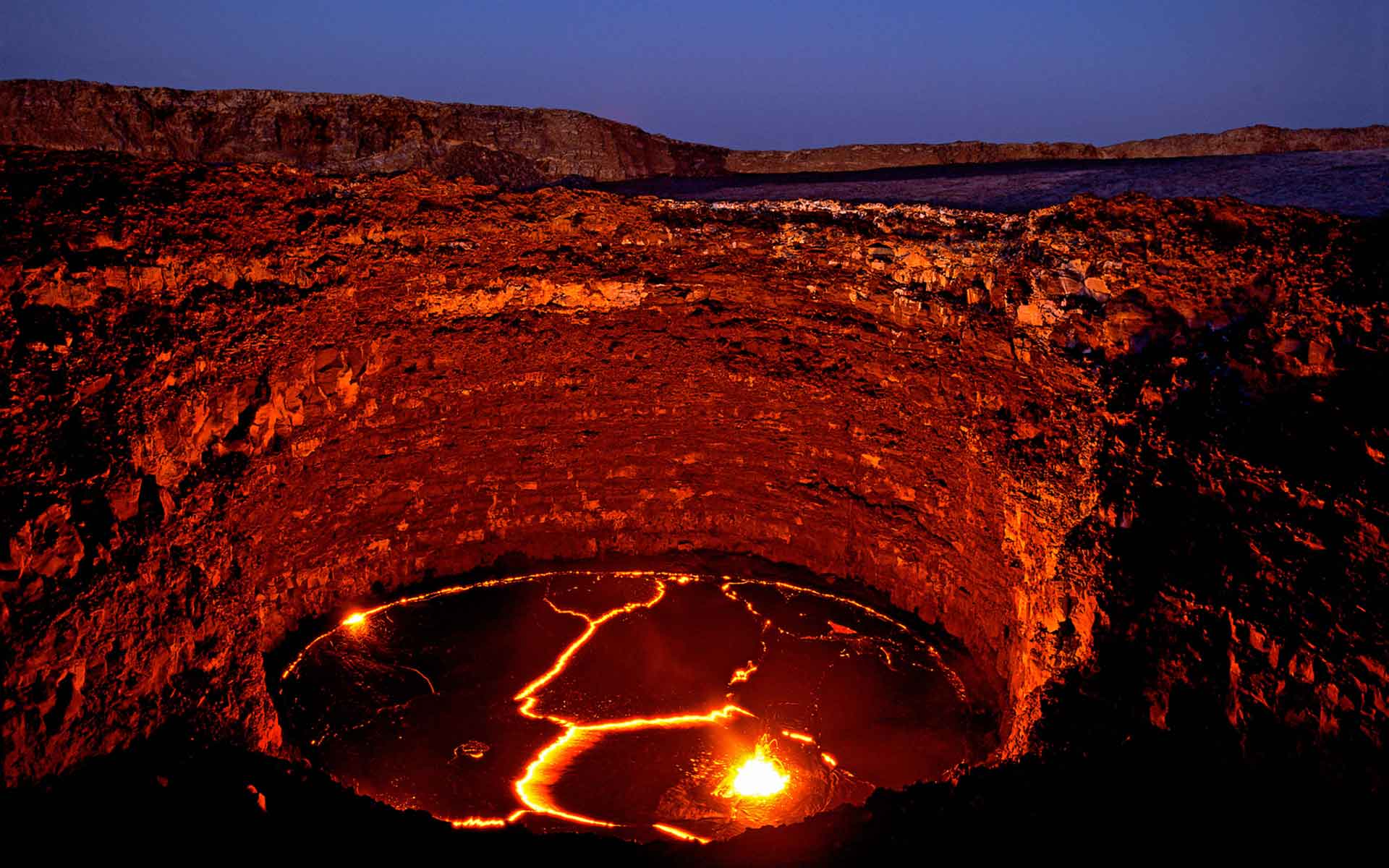
Dallol acidic brines. Dried sulfur mounds are at the center of the acidic brines (Copyright: Olivier Grunewald).
Geological Period
Miocene – Quaternary
Main geological interest
Volcanology
Tectonics
Location
Ethiopia and Eritrea, Northern Afar.
12°45’00.0″N, 40°00’00.0″E
Dallol acidic brines. Dried sulfur mounds are at the center of the acidic brines (Copyright: Olivier Grunewald).
The ongoing birth of an ocean witnessed through tectonics and volcanism in an extreme evaporite arid environment.
A site where the birth of a new ocean is happening and new oceanic crust is forming can be observed at the surface in the Danakil Depression. The region boasts several iconic and spectacular geological sites: Ert’ale volcano with an active lava lake, the Dallol geothermal area with uniquely important polyextreme environment (brines, active geysers, and other hydro-thermal and saline systems), and several salt lakes Despite being an extreme environment, the salt has been mined for centuries by traditional miners and continues to date It is a major tourist destination with geosites as attractions (Dalol, the salt caravans, and the Ert’ale volcano).
- Geological description
The Danakil Depression (also known as the Afar Depression) is a segment of justformed oceanic crust, a young ocean rift (Makaris and Ginzburg, 1987), where rift floor is 120m below sea level. The floor is cut by faults and dotted with many and diverse shield volcanoes (Varet, 1978; Asrat, 2016). The Danakil Depression shows considerable diversity of geological formations ranging from Miocene volcanoes to Holocene sedimentary and volcanic units (Varet, 1978; Beyene and Abelsalam, 2005). The Afar Stratoid Series of mostly Pliocene flood basalts (4-1 Ma) covers two thirds of the Afar depression (Varet, 1978; Beyene and Abelsalam, 2005). Recent volcanic eruptions (<1 Ma) at rift-axial volcanic ranges are characterized by fissure eruptions and shield volcanoes with basaltic flows and with alkaline and per-alkaline silicic rocks occur along northwest-southeast trending narrow volcano-tectonic rift zones (Wright et al., 2006). The axial volcanic shields include Erta’Ale, Tat’Ale and Alayta volcanic shield complex, the Alayta-and Manda-Hararo range, the spectacular Dallol geothermal area, and the Alid volcano, a unique ‘crater of elevation’. The floor of the Danakil depression is underlain by Pliocene sedimentary rocks (succession of gypsiferous clastic and carbonate rocks including coral reefs, thick salt Quaternary sediments (evaporitic to marine sediments with coral and oyster beds). The depression floor is covered by several salt lakes and thick salt formations.
- Scientific research and tradition
The Afar region, particularly the Afar Depression has been the subject of intensive geological and geophysical investigation since the 1960s and mostly since the 1990s in order to understand its unique geological setting as a natural laboratory for active seismic, volcanic, and seismo-volcanic processes. Recently the polyextreme environment of Dallol has been investigated with astrobiological perspectives.
- Reference
Asrat, A. (2016) ‘The Danakil Depression’, in Africa’s Top Geological Sites. Anhaeusser, C. R., Viljoen, M. J., Viljoen, R. P. Cape Town: Struik Nature, pp. 189–196.
Beyene, A. and Abdelsalam, M.G. (2005) ‘Tectonics of the Afar Depression: A review and synthesis’, Journal of African Earth Sciences, 41(1), pp. 41–59. Available at: https://doi.org/10.1016/j.jafrearsci.2005.03.003.
Makris, J. and Ginzburg, A. (1987) ‘The Afar Depression: transition between continental rifting and sea-floor spreading’, Tectonophysics, 141(1), pp. 199–214. Available at: https://doi.org/10.1016/0040-1951(87)90186-7.
Varet, J. (1978) Geology of central and southern Afar (Ethiopia and Djibouti Republic), Map and report. Paris: Centre national de la recherche scientifique.
Wright, T.J. et al. (2006) ‘Magma-maintained rift segmentation at continental rupture in the 2005 Afar dyking episode’, Nature, 442(7100), pp. 291–294. Available at: https://doi.org/10.1038/nature04978.
- Author(s)
Botswana International University of Science and Technology, Palapye, Botswana

